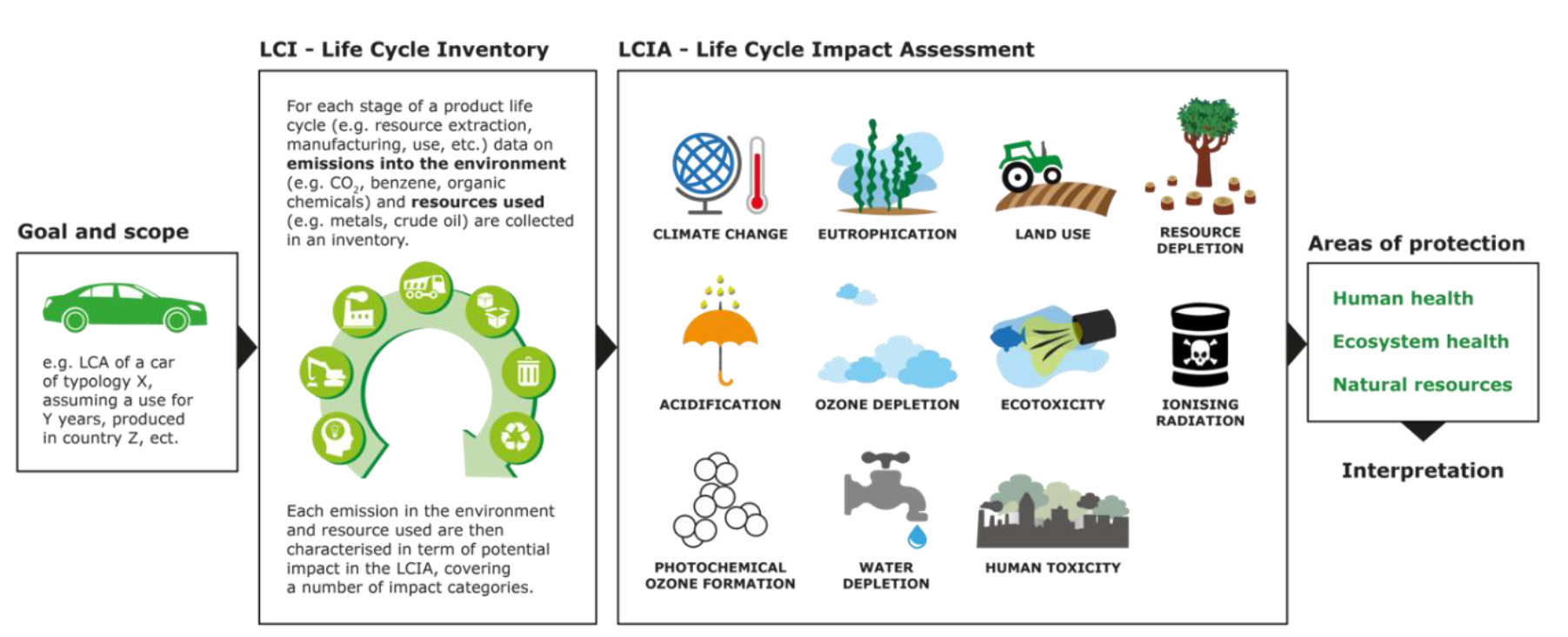LCA is defined by the ISO 14040 as the compilation and evaluation of the inputs, outputs and the potential environmental impacts of a product system throughout its life cycle. Along the lines of this standard and with the main aim to support LCA practitioners in operationalizing LCA, other codes of practice have been developed. In the EU context, the Joint Research Centre of the European Commission has released the International reference Life Cycle Data system handbook. Since 2013, to enhance the comparability of LCA applied to products and organisations, the European Commission has launched the Environmental Footprint methods.
LCA methodology phases
LCA is based on 4 main phases (as in figure): 1) goal and scope 2) inventory analysis, 3) impact assessment, 4) interpretation.

Figure: Life Cycle Assessment steps: goal and scope definition, life cycle inventory, life cycle impact assessment and interpretation (Sala et al., 2016)
In the goal and scope phase, the aims of the study are defined, namely the intended application, the reasons for carrying out the study and the intended audience. Main methodological choices are made in this step, in particular the exact definition of the functional unit, the identification of the system boundaries, the identification of the allocation procedures, the studied impact categories and the Life Cycle Impact Assessment (LCIA) models used, and the identification of data quality requirements.
The Life Cycle Inventory (LCI) phase involves the data collection and the calculation procedure for the quantification of inputs and outputs of the studied system. Inputs and outputs concern energy, raw material and other physical inputs, products and co-products and waste, emissions to air/water/soil, and other environmental aspects. Data collected concern foreground processes (e.g. for a consumer good manufactures, the manufacturing and packaging of a product) and background processes (e.g. for a consumer good manufactures, the production of purchased electricity and materials). Data are validated and put in relationship to the process units and functional unit.
In the Life Cycle Impact Assessment (LCIA) phase, LCI results are associated to environmental impact categories and indicators. This is done through LCIA methods which firstly classify emissions into impact categories and secondly characterize them to common units so as to allow comparison (details on the LCIA are presented in the section below).
Finally, in the Life Cycle Interpretation phase, results from LCI and LCIA are interpreted in accordance to the stated goal and scope. This step includes completeness, sensitivity and consistency checks. Uncertainty and accuracy of obtained results are also addressed in this step.
FURTHER DETAILS ON THE LIFE CYCLE IMPACT ASSESSMENT (LCIA)
Once the inventory data on the life cycle of product are compiled, the environmental performance of the product shall be evaluated by means of the Life Cycle Impact Assessment (LCIA) phase. It includes four additional sub-steps (classification, characterisation, normalisation and weighting) as following detailed.
| Step | Example |
| Classification Classification requires assigning the material/ energy inputs and outputs inventoried to the relevant impact category. | For example, during the classification phase, all inputs/ outputs that result in emissions of greenhouse gasses (e.g. CO2, methane, etc.) are assigned to the climate change impact category. |
| Characterisation Characterisation refers to the calculation of the magnitude of the contribution of each classified input and output to their respective impact categories, and aggregation of the contributions within each category. This is carried out by multiplying the inventoried values by the relevant characterisation factor for each impact category considered. The characterisation factors are substance- or resource-specific. They represent the impact intensity of a substance relative to a common reference substance for an impact category (and used to calculate the relative impact category indicator(s)). | For example, when calculating climate change impacts, all the greenhouse gas emissions previously inventoried in the LCI are weighted in terms of their impact intensity relative to carbon dioxide (expressed as kg of CO2 equivalents). |
| Normalisation Normalisation is the step in which the life cycle impact assessment results are multiplied by normalisation factors to calculate and compare the magnitude of their contributions to the impact categories, relatively to a reference unit. As a result, dimensionless, normalised results are obtained. These reflect the burdens attributable to a product relative to the reference unit. According the ISO 14040 standard, normalization is an optional phase. Within the PEF / OEF methods, the normalisation phase is mandatory. | In the PEF the normalization factors are expressed as impact per capita, based on a global value. For example, the factor for climate change is 8.1∙103 kg CO2eq./person. |
| Weighting Weighting supports the interpretation and communication of the results of the analysis. In this step, normalised results are multiplied by a set of weighting factors (in %) which reflect the perceived relative importance of the life cycle impact categories considered. Weighted results of different impact categories may then be compared to assess their relative importance. They may also be aggregated across life cycle impact categories to obtain a single overall score. According the ISO 14040 standard, weighting is an also optional phase. Within the PEF / OEF methods, the weighting phase is mandatory. | For example, the weighting factor in the PEF for climate change is about 21%, representing the relative relevance of this impact compared to the other categories. |